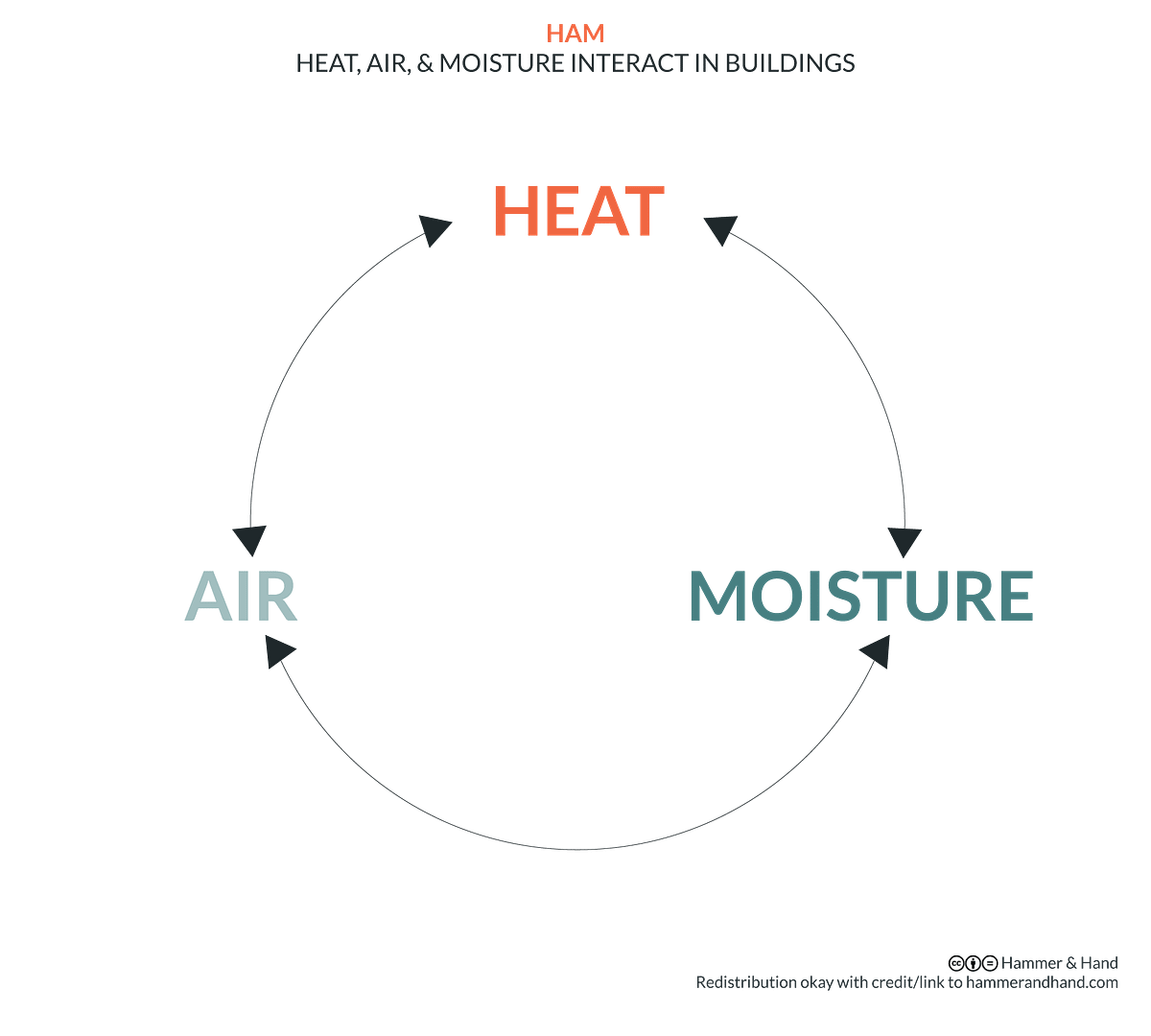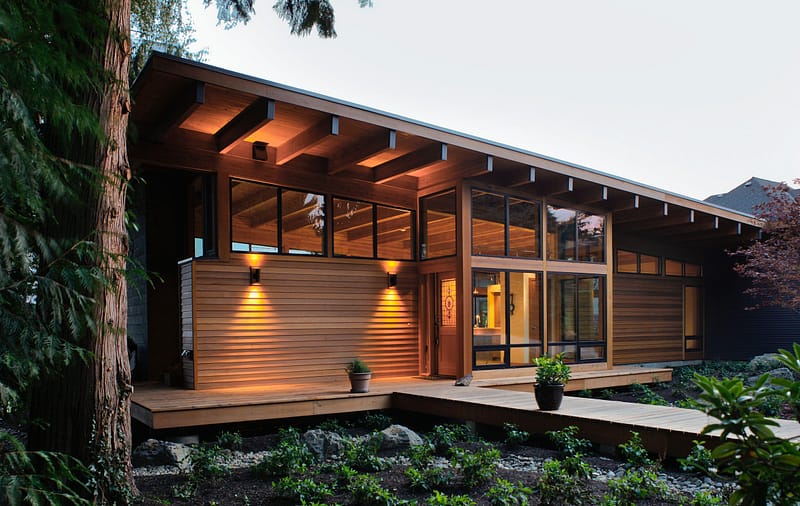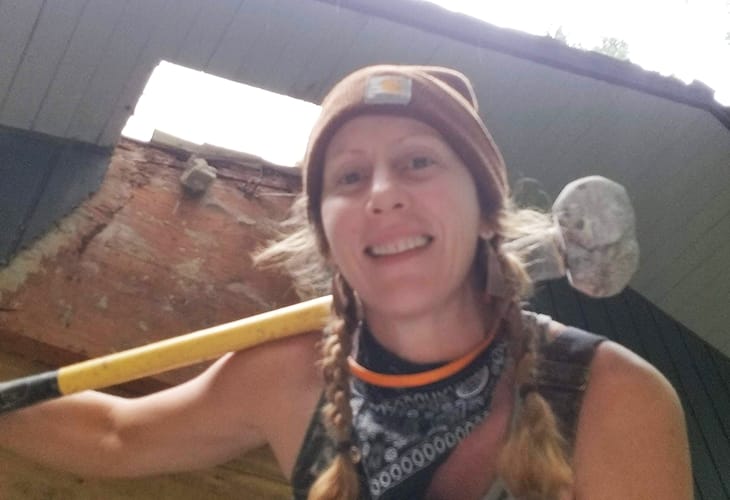The first bit of building science knowledge that any aspiring high performance builder should master is HAM: how heat, air, and moisture collude to affect the performance and durability of buildings and building assemblies.

The components of HAM must be understood in two ways. First, heat, air, and moisture should each be understood on its own terms. With heat, that means understanding air temperature, surface temperature, material temperature, and most importantly, conduction, convection, and radiation. With air it means tracking air movement, air quality, air as a transfer medium, and air as a source of health and comfort. With moisture it means accounting for moisture from the sky, moisture from the ground, moisture in our construction materials, moisture from our bodies, and moisture from occupant activities (boiling spaghetti, housing big lazy dogs, etc.)
Secondly, heat, air, and moisture should be understood in juxtaposition with one another. How do heat and air, air and moisture, and moisture and heat interact? And, more dynamically, how does each element relate to the other two as part of a triangle, each element affecting the other two?
Some quick examples off the top of my head…
What happens when you burn the toast? What happens when you take a shower? What happens when you have a party and the house is full of people? What happens to your house in wintertime when it’s cold outside and warm inside? What happens when it rains really hard for a long, long time and the webs start to grow between your toes…and you’re huddled alone in front of your happy light in your t-shirt and skivvies…and it’s still raining, and the ground is saturated, and it just keep raining and raining…and your gutters get clogged and overflow, and the wind begins to blow really hard, and then it freezes, and then it gets warmer, and it freezes again and it snows…okay, nevermind, that doesn’t happen very often where we live.
But each one of these situations can be examined through the lens of HAM (which, incidentally, is a Viking village where my ancestors once sailed.) Let’s flesh out a couple examples…
Situation One. It’s been raining for days, and a big storm is moving in from the west. (The direction of the storm is not important, but thank you for reading so closely.) The storm is characterized by high, sustained winds. The wind pressurizes the sides of the building that it hits and, due to the Venturi effect, actively depressurizes the lee side of the building. The wind drives the rain almost horizontally against the face of the building, effectively negating the function of the overhangs and other structures meant to protect the façade. It’s like a giant pressure washer spraying the side of the building, except the house is now a vacuum and it’s sucking the air in, and the water’s coming with it. Remember when you were installing flashing on a window and your boss would say, “think like a raindrop”? He was only half right, because under the conditions described above water will run uphill as it follows the air that’s entering the building from a high pressure zone to a low pressure zone. So all your fancy flashings and properly lapped components are effectively defeated on a regular basis.
Situation Two. Let’s say its cold outside, say 40 degrees, and the house is at 70 degrees (F), and you’re cooking all day for a party that night. The dew point (the temperature at which condensation forms) of the air outside is a very low 32 degrees because cold air carries less water. It’s an energy thing. But inside the house, with all the cooking and partying and yammering, it’s 75 degrees with relative humidity of 85%, much higher than normal. That air has a dew point of 70 degrees. So as the hot air moves toward the cold air through the building envelope and vice versa, the water vapor from the inside hits lower temperatures and condenses into liquid water, often inside the envelope structure, often close to the outside of the envelope (on the back of the sheathing, for instance). The condensation will just collect there, even without much air movement, because the dew point is high and it’s warm and wet inside the building. This is a problem.
Heat, air, and moisture all play starring roles in these two examples. Situation One stars air and moisture. The character playing the air in this scene is the wind. Rain plays the role of moisture. If you study our best practices manual, you’ll see how we now deal with that at Hammer & Hand. Situation Two stars all three sides of the HAM triangle. It’s a perfect vignette, when seen through the lens of HAM. Moisture is played by the water vapor in the air, with higher levels inside the house and lower on the outside. The air again acts as the agent of transfer with heat as the engine. Higher temperatures allow the air to carry more moisture. Heat, air, and moisture all seek to balance the differentials across the building envelope. Hot moves to cold and wet moves to dry, both enabled by air movement through a leaky assembly. And you’ve got a wet sloppy mess inside your wall.
We need to control air movement in an effort to minimize moisture and heat transfer.
So there’s your introduction to what is a complex and important topic in our world – one that we’ll delve into deeper here soon. Heat, air, and moisture guide our work in the field, especially in high performance building where increased thermal resistance of assemblies decreases drying potential. Our approach to Passive House wall construction, for example, has evolved to manage heat, air, and moisture in an optimized way.
Let the lens of HAM be your guiding light when you venture forth into the land of building science.
Drops photo above by Final Gather (some rights reserved under a creative commons license).




